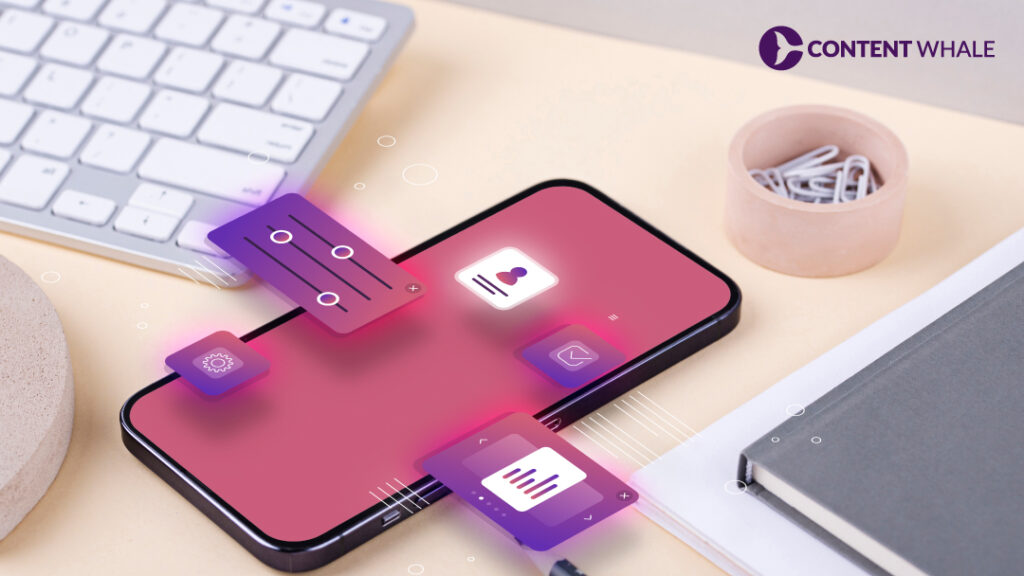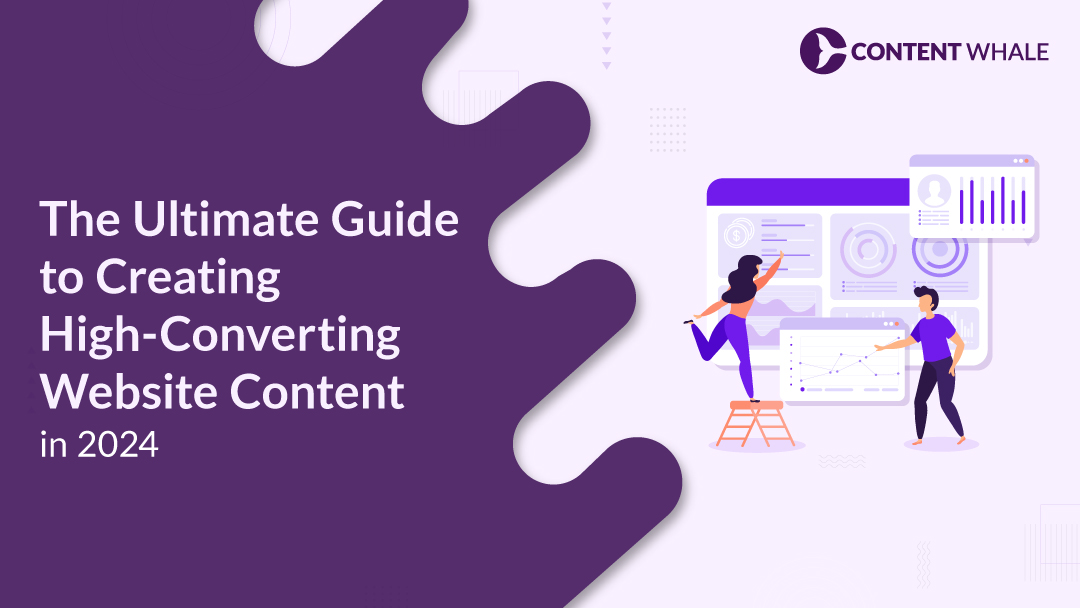Crafting high-converting website content is essential for businesses aiming to increase website conversions and turn visitors into loyal customers. In 2024, Creating High-Converting Website Content that not only captures attention but also drives action is more important than ever.
This guide breaks down the content marketing strategy you need to follow, with a focus on improving user engagement and providing a seamless user experience (UX). From mastering website copywriting to incorporating visual storytelling and ensuring mobile responsiveness, we’ll cover the key elements that will help optimize your content for better results.
Whether you’re aiming for better SEO best practices or looking to enhance your conversion rate optimization, you’ll find actionable strategies here to boost your website’s performance.
1. Understanding Your Audience for Targeted Content
Successful creating high-converting website content starts with deeply understanding your audience. Tailoring your message to their specific needs is essential for any effective content marketing strategy. In 2024, data-driven insights and segmentation are crucial for delivering engaging website content that drives results.
Here are some best practices:
a) Audience Research Methods
- Tools like Google Analytics and CRM systems offer valuable insights into demographics, interests, and behavior patterns.
- By analyzing traffic sources, user experience (UX) behavior, and interactions, you can segment your audience effectively.
- Social media platforms also offer robust analytics for identifying trends and audience preferences. This enables you to create personalized content that enhances user engagement.
b) Aligning Content with Buyer Intent
- Align your content with each stage of the buyer’s journey. For instance, blog posts and educational resources work well for top-of-funnel audiences, while conversion rate optimization strategies such as targeted CTAs and offers appeal to those ready to convert.
- This approach ensures that your content optimization focuses on driving website conversions by addressing real customer needs.
c) Personalization and User Segmentation
- Content personalization plays a significant role in improving engagement and conversions. Use dynamic content tools and AI-driven analytics to customize the website experience for different user segments.
- Personalized call-to-action buttons and product recommendations can enhance conversion rates by providing a tailored user experience.
- Moreover, mobile responsiveness ensures seamless interaction for mobile users, increasing your chances of retaining traffic.
2. Creating Compelling Headlines and Copy

An effective headline is the gateway to your content, setting the stage for creating high-converting website content. It has a direct impact on website conversions because it determines whether your audience will click and engage further. Crafting a headline that grabs attention requires a mix of creativity, relevance, and the right emotional triggers.
Here are some essential tips:
a) Make It Clear and Actionable
- Readers should instantly understand what they will gain from your content. For example, instead of vague headlines, offer a clear benefit like, “10 Proven Ways to Boost Your Website’s Conversions” or “How to Craft Compelling Copy That Drives Action.”
- These types of headlines use website copywriting techniques that directly address what the audience needs, creating a strong hook.
b) Use Power Words and Emotional Triggers
- Integrating words that evoke emotion or create urgency can significantly increase engagement.
- Words like “amazing,” “breakthrough,” or “ultimate” create excitement, while phrases like “limited time” or “don’t miss out” encourage immediate action.
- These are effective tools to use alongside call-to-action elements in your copy, urging readers to dive deeper into the content.
c) Test and Refine with A/B Testing
- One headline does not fit all audiences. Running A/B tests on your headlines allows you to identify which ones resonate best with your target segments.
- For instance, you might test whether a benefit-focused headline like “Increase Your Conversions with These 7 Techniques” performs better than a curiosity-driven headline such as “You Won’t Believe These Conversion Boosting Secrets.”
- Regular testing helps optimize for better conversion rate optimization.
d) Incorporate Keywords Naturally
- While it’s important to use SEO best practices, make sure your keywords fit naturally within your headlines.
- Overloading a headline with too many keywords can feel forced. Instead, balance between the primary keyword and a compelling promise, such as “Creating High-Converting Website Content: The Ultimate Guide to Increasing User Engagement.”
e) Keep It Concise and Clear
- Headlines should be punchy and to the point. Avoid long-winded phrases. Stick to a structure that conveys the message quickly, ideally within 6-12 words.
- Conciseness is key for both desktop and mobile responsiveness, where space is limited.
f) Use Numbers for Specificity
- Including numbers in your headlines can increase user engagement. For instance, “5 Strategies for Content Personalization That Drive Results” is more attractive because it promises specific, actionable insights.
- Numbers also help readers quickly understand the scope of the content.
3. Visual Storytelling: The Power of Images and Video
In 2024, visual storytelling has evolved into a powerful tool for engaging and retaining audiences. High-quality visuals, such as images and videos, are essential for creating high-converting website content. They serve as a bridge between brands and consumers, capturing attention and evoking emotions in ways that text alone cannot.
Here’s how you can leverage the power of visual storytelling effectively:
a) Engage with High-Quality Visuals
- Whether it’s images, infographics, or videos, visuals enhance user engagement by making content more digestible and memorable.
- People are wired to process visuals faster than text, which can significantly boost the retention of your message.
- When you integrate compelling visual storytelling, you increase the chances of creating a strong connection with your audience, leading to higher website conversions.
b) Use Video to Boost Conversions
- Video is an incredibly effective medium for storytelling. It combines visual elements with sound, making it a dynamic tool to communicate complex ideas in an engaging way.
- Short-form videos, tutorials, and product demonstrations can increase viewer interaction, making your content more shareable and effective in driving conversion rate optimization.
- Interactive videos can also invite users to explore features further, deepening their involvement.
c) Incorporate Emotional Storytelling
- Successful visual stories are those that tap into emotions, whether it’s joy, inspiration, or curiosity.
- For instance, brands like Nike have used visual storytelling in their campaigns to evoke emotions of ambition and perseverance.
- Emotions help create an intimate connection between the viewer and the brand, making it more likely for users to take action, such as completing a purchase or signing up for a newsletter.
d) Enhance Content with Interactive Visuals
- Interactive content, such as infographics with clickable elements or video content that allows users to make choices, can significantly improve engagement.
- Interactive visuals increase user experience (UX) by keeping users immersed in the story you are telling.
- This leads to better content optimization and higher retention rates, ultimately contributing to more conversions.
| # | Aspect of Visual Storytelling | Description | Impact |
| 1 | Emotional Appeal | Visuals like images and videos evoke emotions, creating stronger connections with the audience. | Increases engagement and content retention, making the message more memorable. |
| 2 | Dynamic Content | Videos allow for storytelling through motion and transitions, keeping viewers engaged longer than static images. | Boosts viewer retention and improves message delivery by making the content more exciting. |
| 3 | Educational Value | Visual storytelling explains complex ideas clearly, often used in explainer videos to simplify intricate concepts. | Enhances understanding of the topic, making it accessible to a broader audience. |
| 4 | High Engagement Rates | Visuals outperform text in capturing attention and driving interaction on social media and websites. | Drives higher engagement, shares, and interaction rates, improving visibility. |
| 5 | Increased Information Retention | Visual content helps viewers remember information better than plain text alone. | Boosts recall and long-term retention of information. |
| 6 | Mobile and Social Media Friendly | Visual storytelling fits perfectly into mobile and social platforms, where short videos and images thrive. | Increases shares and views on mobile and social media, broadening reach. |
| 7 | Authenticity | Visuals, especially user-generated content and testimonials, build trust and emotional connection. | Strengthens brand credibility and fosters emotional connection with the audience. |
| 8 | SEO and Marketing Impact | Properly optimized visual content enhances SEO performance and increases site visibility. | Improves rankings on search engines and increases website traffic. |
4. Mobile-First and Responsive Design

With over half of all web traffic coming from mobile devices, mobile-first design has become a critical strategy for websites in 2024. Creating a mobile-responsive website that adapts to different screen sizes isn’t just about convenience; it directly impacts user engagement, site speed, and ultimately website conversions.
Here’s how you can optimize for mobile-first and responsive design:
a) Prioritize Mobile Usability
- Mobile users expect fast and intuitive experiences. Designing for mobile-first means focusing on small screen functionality first, ensuring that buttons are easily tappable, menus are simple to navigate, and content is easily readable on smartphones.
- This improves both user experience (UX) and conversion rate optimization by reducing the friction users face on smaller devices.
b) Fast Loading Times Matter
- Mobile users often have slower internet connections compared to desktop users. Site speed is critical for mobile-first design, as slow load times can result in higher bounce rates.
- Compressing images, minifying CSS and JavaScript, and using content delivery networks (CDNs) can significantly improve performance on mobile devices.
c) Responsive Layouts with Fluid Grids
- A responsive design ensures that your website adjusts seamlessly across different screen sizes, from small smartphones to large desktops.
- Use media queries and fluid grid systems to adapt your layout for different devices.
- This not only improves mobile responsiveness, but also ensures consistency in how your engaging website content is displayed across all devices.
d) Simplified Navigation for Mobile
- Ensure your mobile design features easy-to-navigate menus and prominent call-to-action (CTA) buttons that users can access quickly.
- Incorporating a clean website design with a simplified navigation structure helps improve usability, leading to higher website conversions.
e) SEO Benefits
- Google now prioritizes mobile-friendly sites with mobile-first indexing, meaning your mobile site is critical for SEO.
- A well-optimized mobile site will improve your rankings, drive more traffic, and ultimately result in better content optimization for conversions.
| # | Benefit | Description | Impact |
| 1 | Improved User Experience (UX) | A mobile-first design ensures your website adapts seamlessly to all screen sizes, providing users with an optimized experience. | Increases user satisfaction, leading to better engagement and lower bounce rates. |
| 2 | Faster Loading Times | Mobile-first designs are typically lighter, which improves load times on mobile devices. | Reduces page abandonment and improves overall website performance. |
| 3 | Higher Search Engine Rankings | Search engines like Google prioritize mobile-friendly websites, improving visibility. | Enhances SEO performance, increasing organic traffic and ranking. |
| 4 | Increased Accessibility | Ensures the website is accessible across various devices, particularly smartphones and tablets. | Broader audience reach, as users can access the site regardless of their device. |
| 5 | Reduced Bounce Rates | By improving mobile UX and loading times, users are less likely to leave the site. | Boosts conversion rates and improves session duration. |
| 6 | Cost-Effective | A single mobile-first design approach reduces the need for separate designs for different devices. | Lowers development and maintenance costs over time. |
| 7 | Adaptability to Future Devices | Mobile-first design is more adaptable to new devices and screen sizes. | Future-proofs the website, ensuring it remains functional and relevant as technology evolves. |
| 8 | Better Conversion Rates | With improved usability and performance, mobile-first designs can lead to higher conversions. | Drives more sales, sign-ups, or other desired actions from mobile users. |
5. SEO-Optimized Content for Conversion
To drive website conversions in 2024, optimizing your content for SEO is essential. High-ranking content not only boosts traffic but can also turn visitors into customers when aligned with conversion rate optimization strategies. Here’s how you can ensure your content is SEO-optimized for better conversions:
a) Use Targeted Keywords Effectively
- Keyword research is the backbone of SEO best practices. Focus on high-intent, long-tail keywords that directly align with the search queries of users who are closer to making a purchase or taking action.
- Tools like Semrush can help you identify keywords that signal strong intent, such as “best content optimization strategies” or “how to increase website conversions.”
- These keywords are easier to rank for and tend to attract more qualified traffic, which boosts conversion rates.
b) Optimize for Featured Snippets and Voice Search
- With the rise of voice search and featured snippets, optimizing for concise, question-based queries is critical. Create content that provides clear, direct answers to frequently asked questions.
- For instance, a brief but valuable response to “What is SEO-friendly content?” followed by detailed information can help your page rank in position zero, which increases visibility and click-through rates (CTR).
c) Enhance Meta Tags and Descriptions
- Your meta titles and descriptions play a crucial role in attracting clicks. Although these elements don’t directly affect ranking, they influence whether users will visit your page from search results.
- For example, writing a meta description like “Learn how to create SEO-optimized content for higher conversions in 2024” captures both the primary keyword and a clear benefit, improving CTR.
d) Improve Content Structure for Better SEO and Usability
- A clear, well-structured format improves both user experience (UX) and SEO. Use headings and subheadings to break up the content, making it easier to read and navigate.
- These organizational cues help search engines understand your content and boost your chances of ranking higher.
- Well-structured content not only engages visitors but also keeps them on the page longer, which increases the likelihood of conversions.
e) Leverage Internal Linking for SEO and Engagement
- Internal links guide users through related content, improving their journey on your site.
- By linking to other relevant pages, you enhance your site hierarchy and increase the crawlability of your site for search engines.
- This not only helps with SEO but also keeps users engaged longer, which can lead to higher conversion rates.
f) Optimize for Speed and Mobile Responsiveness
- Mobile responsiveness and site speed are crucial factors in both SEO and conversions.
- Google prioritizes mobile-friendly sites in its rankings, and a fast-loading, mobile-optimized site improves user engagement and lowers bounce rates.
- Ensure your images are compressed, your code is optimized, and your site’s mobile experience is seamless to keep users on your page, increasing the chances they’ll convert.
6. The Role of Interactive and Engaging Content
Interactive content has become an essential part of creating high-converting website content in 2024. It’s not enough to provide static information; engaging your audience with dynamic, personalized experiences is key to boosting user engagement and driving website conversions.
Here’s how to effectively leverage interactive content:
a) Quizzes and Polls for Audience Interaction
- Interactive elements such as quizzes and polls help captivate your audience, prompting them to participate actively in your content.
- This not only boosts engagement but also allows you to gather valuable insights about your visitors.
- For instance, quizzes can provide personalized results that align with user preferences, enhancing the overall user experience (UX).
b) Interactive Videos
- Adding clickable elements like hotspots and annotations to videos can turn passive viewing into an engaging experience.
- Interactive videos allow users to explore content at their own pace and dive deeper into topics that interest them.
- This strategy is a perfect fit for video marketing in 2024, offering immersive experiences that drive higher retention and conversion rate optimization.
c) Surveys and Feedback
- Surveys provide a direct way to gather user input while making the content experience more engaging.
- For instance, after a visitor completes an action on your site, a quick feedback survey can enhance content personalization by helping you understand what worked and what could be improved.
d) Personalization with Dynamic Content
- In 2024, personalization remains a major trend. Interactive content can be tailored to individual preferences, offering dynamic responses based on user input.
- This can significantly increase user engagement as visitors feel the content is relevant to them.
- For example, personalized call-to-action (CTA) buttons can improve conversion rates by presenting tailored offers or suggestions based on prior behavior.
e) Gamification
- Turning content consumption into a game is a fun and effective way to keep users engaged.
- Leaderboards, point systems, or rewards for completing tasks provide incentives for users to interact with your content.
- This playful approach increases user participation and helps foster a sense of achievement, leading to more engaging website content.
f) Interactive Infographics
- Infographics have been popular for presenting complex data visually, but adding interactive elements takes this further.
- Allowing users to explore data or click through different sections of an infographic can make it more engaging, increasing the likelihood of shares and boosting website conversions.
7. Building Trust with Social Proof and Security Signals
In 2024, building trust through social proof and security signals is a cornerstone of creating high-converting website content. These elements are crucial for boosting user engagement, enhancing credibility, and ultimately driving website conversions.
Here’s how you can effectively use social proof and security signals:
a) Testimonials and Reviews
- Customer testimonials and reviews remain one of the most persuasive forms of social proof. Showcasing genuine, transparent feedback from satisfied customers provides new visitors with reassurance that your product or service can meet their needs.
- According to recent studies, more than 70% of consumers trust a brand with positive reviews and testimonials, making this an essential component for any content marketing strategy.
- Feature these prominently on your website’s homepage or product pages to improve conversion rate optimization.
b) User-Generated Content (UGC)
- Encouraging user-generated content, such as photos, videos, and social media posts from your customers, adds a layer of authenticity.
- It helps create a community around your brand and increases the likelihood of new customers trusting your offerings.
- UGC also plays into the power of content personalization, showing that others have had a positive experience, making your content more relatable and credible.
c) Case Studies and Success Stories
- Detailed case studies go beyond simple testimonials, offering an in-depth look at how your product or service has solved real-life problems for clients.
- These compelling stories provide a narrative that potential customers can connect with, giving them confidence in your ability to deliver results.
- Case studies offer a deeper form of social proof that reinforces trust and drives conversions, especially for B2B businesses.
d) Trust Badges and Certifications
- Trust badges like SSL certificates, secure payment icons, and privacy certifications signal to visitors that your site is secure and trustworthy.
- Displaying these badges, especially on landing pages and checkout sections, reassures users that their data is protected, encouraging them to complete their transactions.
- Secure checkout badges and money-back guarantees are particularly effective in reducing cart abandonment and building consumer confidence.
e) Social Media Followers and Engagement
- Highlighting your social media presence and follower count can serve as indirect social proof, showing that your brand is well-regarded and followed by many.
- This form of engaging website content reinforces your credibility, especially when combined with high levels of interaction, such as comments and shares.
- It demonstrates that people not only trust your brand but actively engage with it, which can be a strong factor in conversion decisions.
| # | Step | Description | Impact |
| 1 | Showcase Testimonials and Reviews | Display real customer testimonials and reviews to highlight your product’s value and build credibility. | Increases customer confidence and encourages conversions by showing positive customer experiences. |
| 2 | Use Certifications and Awards | Feature industry certifications, security badges (like SSL), and awards prominently on your site. | Reinforces authority and assures customers of data security and product reliability. |
| 3 | Display Case Studies | Provide in-depth case studies demonstrating how your product or service solved specific customer problems. | Builds trust by showcasing real-world results, helping potential customers see the value of your offering. |
| 4 | Add User-Generated Content (UGC) | Incorporate social media content or customer-generated photos and videos that showcase product usage. | Creates authenticity and builds community, enhancing emotional connection with your brand. |
| 5 | Show Client Logos and Partnerships | Display logos of well-known clients or partners your business collaborates with. | Adds credibility by associating your brand with recognized and trusted names. |
| 6 | Highlight Security Seals and Compliance | Feature security seals such as SSL certificates, GDPR compliance, or payment protection icons. | Provides peace of mind, ensuring visitors that their personal and financial information is protected. |
| 7 | Use Money-Back Guarantees and Trial Offers | Offer risk-free trials or money-back guarantees to minimize perceived risk. | Increases likelihood of purchase by reducing the fear of financial loss. |
| 8 | Incorporate Social Proof in Key Sections | Position social proof elements (reviews, logos, awards) in critical areas like product, checkout, and pricing pages. | Encourages decision-making and conversion by presenting trust signals at crucial moments in the buying process. |
Conclusion

Creating high-converting website content in 2024 involves a thoughtful combination of content marketing strategy, design, and optimization techniques. To succeed, you must focus on understanding your audience, providing engaging website content, and using tools like visual storytelling, call-to-action (CTA) buttons, and trust badges to build credibility and trust.
Additionally, ensuring mobile responsiveness and employing ongoing A/B testing are critical to refining your approach and improving conversion rate optimization. By integrating these elements, you can create a seamless user experience that not only attracts visitors but also converts them into loyal customers.
At Content Whale, we specialize in creating high-converting website content that drives results. Our team excels in content marketing strategy, SEO best practices, and content optimization to boost user engagement and conversions. Ready to elevate your website? Contact us today to achieve your business goals.
FAQs
1. What is high-converting content?
High-converting content refers to engaging website content that motivates visitors to take desired actions, such as making a purchase, signing up for a newsletter, or downloading a resource. It blends content marketing strategy with persuasive elements like compelling copy, call-to-action (CTA) buttons, and social proof to guide users through the conversion funnel.
2. How do I improve my website’s conversion rate?
To improve website conversions, focus on content optimization and the user experience. This includes using SEO best practices, creating strong CTAs, integrating A/B testing, and ensuring mobile responsiveness. Engaging visuals, landing page design, and content personalization can also enhance the likelihood of conversion.
3. Why is mobile responsiveness important for conversions?
With more than 50% of web traffic coming from mobile devices, mobile-first design ensures your website performs seamlessly across all screen sizes. Poor mobile experience leads to higher bounce rates, while a well-optimized mobile site boosts user engagement and conversion rates.
4. How can visuals increase conversions?
Visuals such as high-quality images, video marketing, and infographics enhance visual storytelling, making content more engaging and persuasive. This, in turn, improves user experience (UX) and encourages users to take action, which directly impacts conversion rate optimization.
5. What role does A/B testing play in improving conversions?
A/B testing allows you to test different versions of your web pages to see which performs better. By adjusting elements like headlines, CTAs, and visuals, you can refine your strategy to optimize for conversions. Testing helps identify the most effective variations for driving user actions.





